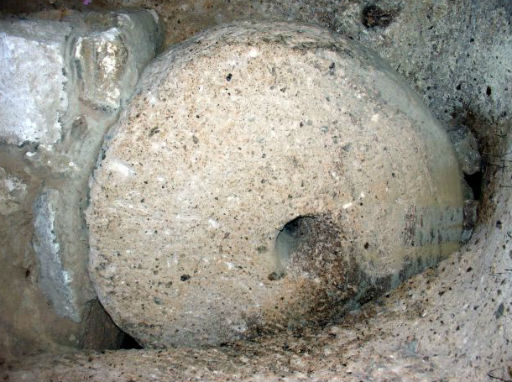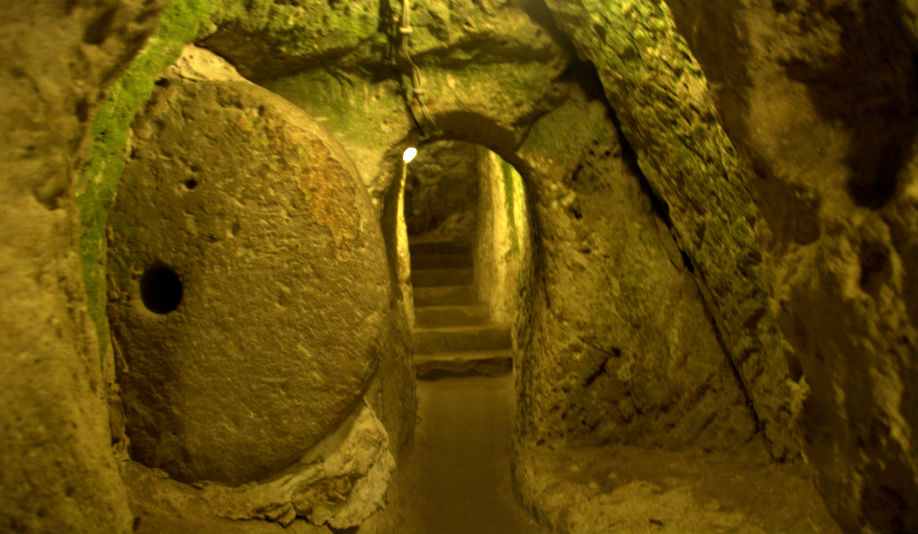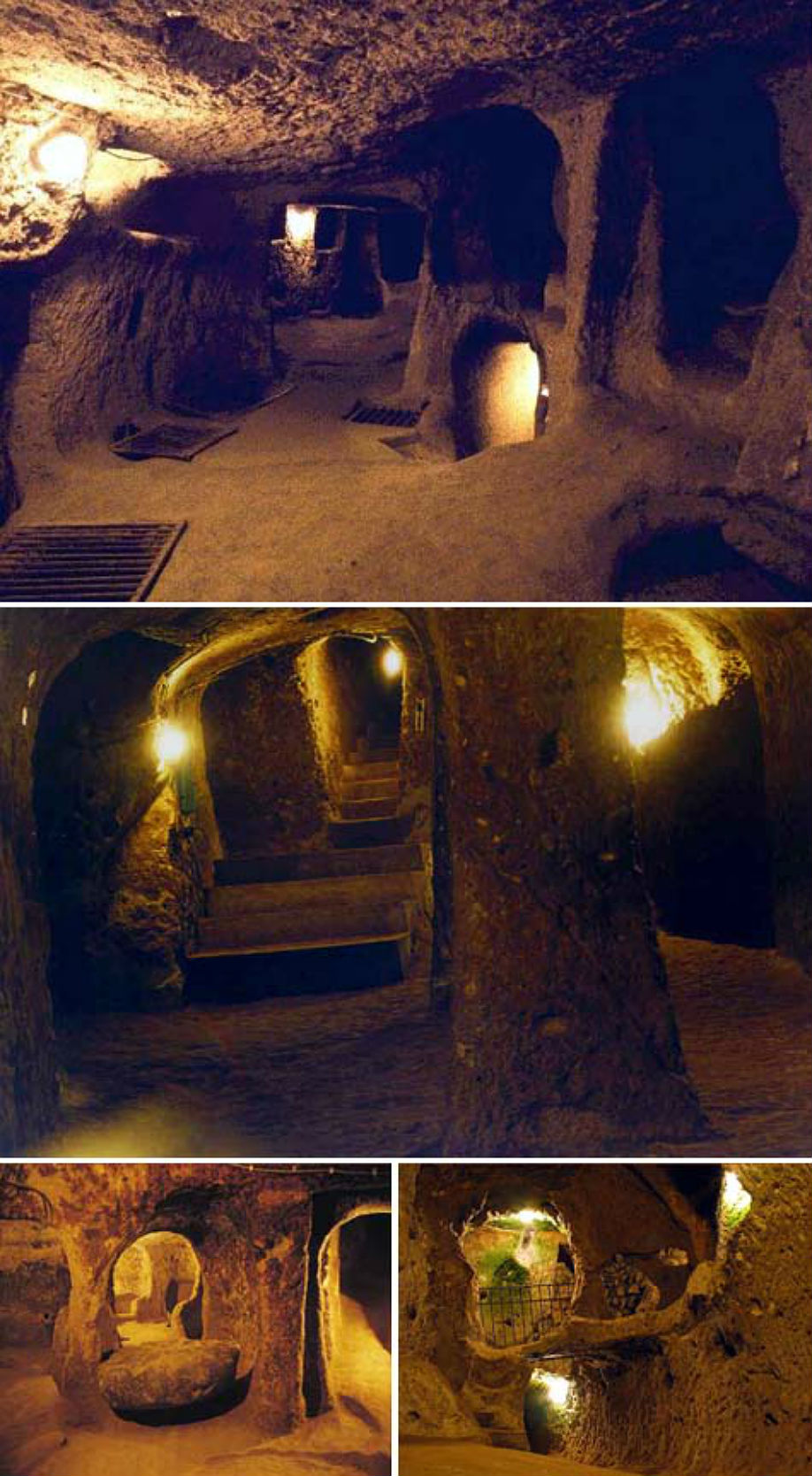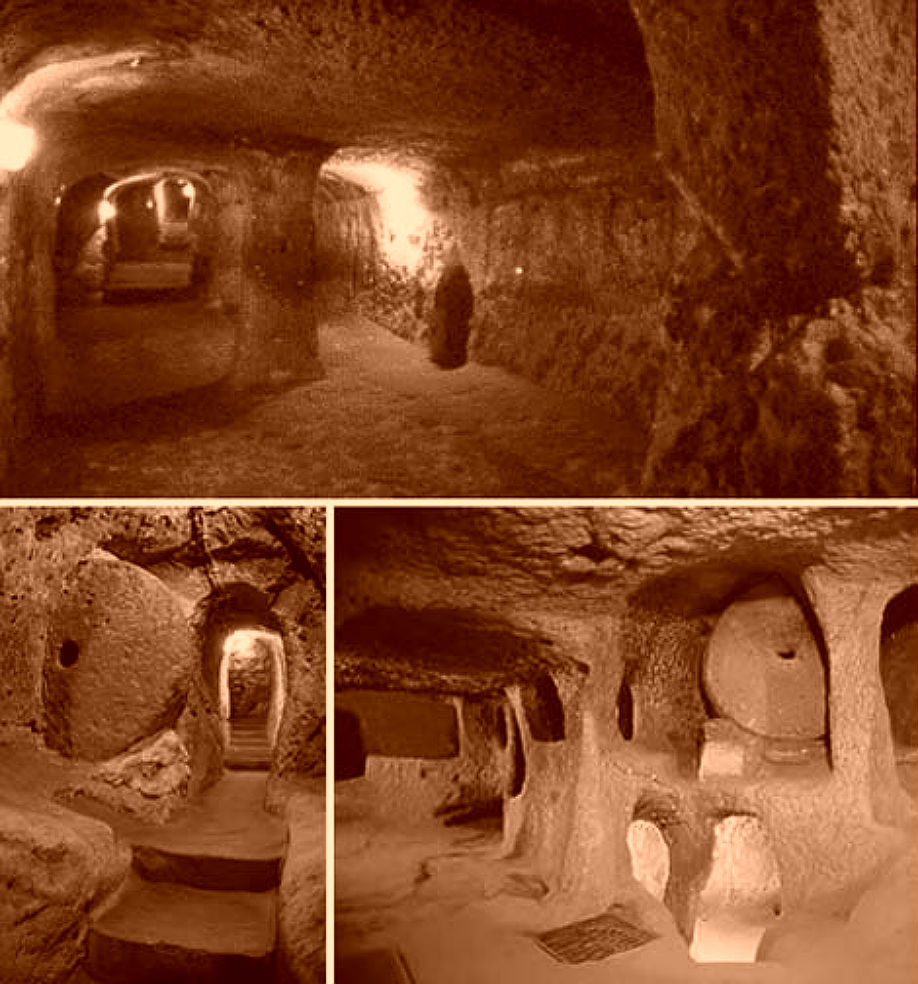Derinkuyu Underground City is an ancient multi-level underground city of the Median Empire in the Derinkuyu district in Nevşehir Province, Turkey.
Extending to a depth of approximately 60 m, it was large enough to shelter approximately 20,000 people together with their livestock and food stores.
It is the largest excavated underground city in Turkey and is one of several underground complexes found across Cappadocia.

One of the heavy stone doors. They have a height of 1–1,5 m, 30–50 cm in width and weigh 200–500 kg. The hole in the centre can be used to open or close the millstone, or to see who is outside.
It was opened to visitors in 1969 and to date, about half of the underground city is accessible to tourists. The underground city at Derinkuyu could be closed from the inside with large stone doors. Each floor could be closed off separately.
The city could accommodate up to 20,000 people and had all the usual amenities found in other underground complexes across Cappadocia, such as wine and oil presses, stables, cellars, storage rooms, refectories, and chapels. Unique to the Derinkuyu complex and located on the second floor is a spacious room with a barrel vaulted ceiling. It has been reported that this room was used as a religious school and the rooms to the left were studies.
Between the third and fourth levels is a vertical staircase. This passage way leads to a cruciform church on the lowest (fifth) level.
The large 55 m ventilation shaft appears to have been used as a well. The shaft also provided water to both the villagers above and, if the outside world was not accessible, to those in hiding.
History
First built in the soft volcanic rock of the Cappadocia region, possibly by the Phrygians in the 8th–7th centuries B.C according to the Turkish Department of Culture, the underground city at Derinkuyu may have been enlarged in the Byzantine era. During the Persian Achaemenid empire the city was used as a refugee settlement. There are references to underground refugee settlements built by the Persian king Yima in the second chapter of the Zoroastrian book Vendidad. Therefore many scholars believe that the city may have been built by the Persians. The city was connected with other underground cities through miles of tunnels.
Some artifacts discovered in these underground settlements belong to the Middle Byzantine Period, between the 5th and the 10th centuries A.D. It is speculated that the number of underground settlements, generally used for taking refuge and for religious purposes, increased during this era.
Derinkuyu Underground City, Cappadocia,





Very unique destination. An underground city to imagine how people stayed there in the past. It showed how people at that time thought about all the important things in the past.Well-built city and a must see destination.
We went on a tour that was well staffed and very knowledgeable guides that had been here many times over. So they knew all of the "great" spots to frequent, and we got some wonderful pictures of all of the old rock churches and homes carved out of the rock faces of the mountains. The cave drawings showed some intricate…
Don't miss this outstanding underground city. Then pay a visit to Gokhan Antiq Shop. The owner Metin Ince is great. You will find so many things to bring home when you visit his shop.
At one time up to 20,000 people lived in Derinkuyu Underground City carved 18 storeys deep into the Cappadocia earth. Today, 8 floors of rooms, tunnels and passageways are open for public viewing
I could not believe in that people lived in that city for months in the old. they had tought everything without any technology but perfect. and I Recommend everyone.
Agzikarahan Caravanserai have been built and used since the 10th century. These buildings provided accommodation and other amenities for the merchants and stabling for their animals. Inside each caravanserai there was also a small mosque for their religious services.
During the times of Seljuk Sultans Kilicarslan II and Alaaddin Keykubat I, the construction of these buildings increased. Merchants of all nationalities were put in the caravanserais with food and beverage all free of charge up to three nights. They could get their shoes repaired. New shoes were given to the poor, and treatment was available for the sick. If the merchants were robbed, the loss of the trades would be compensated by the states. It was the first insurance system in the world.
Its one of the best place to see in cappadocia. Undergroud cities, beautiful Valley and churches. Cappadocia means land of beautiful horses.
We went on this tour with my three boys who thoroughly enjoyed the day. Fascinating underground city, room after room, tunnel after tunnel, everything very clearly marked with green arrows to show us to keep going down (8 floors) and red arrows directing us to exit. Boys loved the very unusual experience. We
Avanos is a pretty town and worth a walk around. Plenty of places to buy distinctive pottery, some of which is handthrown and handpainted and some of which is cast and stencilled. You can also try your hand at 'throwing' a pot. We all left having bought a variety of pieces, from something small to give friends to lovely feature…
This is the Church of the Evil Eye and it is a quiet, infrequently visited site only 10 minutes walk from the main road to the museum from Goreme. Simply follow the signs. We appreciated the opportunity to have an unhindered look around at a place under restoration, and even though the frescoes are not up to the standard of…